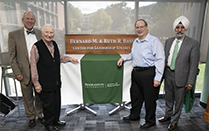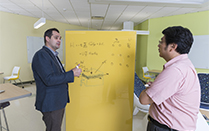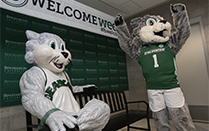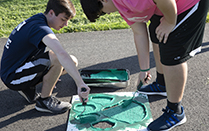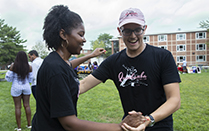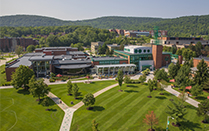Team-taught interdisciplinary courses funded by grants
Binghamton University’s emphasis on interdisciplinary initiatives has spawned noteworthy successes in collaborative research efforts and led to a new grant to encourage faculty to cross disciplinary lines in the classroom. Funded by the Provost’s Office, the grant supports tenured or tenure-track faculty in the creation of team-taught inter/transdisciplinary courses. Two faculty members from different disciplines collaborate to propose a new course – not previously taught either individually or jointly – that brings together each participant’s intellectual strengths and interests to address a particular problem or topic.
Successful proposals receive $4,000 for each faculty participant’s department. The faculty collaborators share a $1,000 course-creation grant, and the course counts as a full course toward each instructor’s teaching obligation.
Three courses were funded for the 2013-14 academic year:
• Interactive Art of Kinetic Object/Moving Image, taught by Koenraad Gieskes, engineering design, and Tomonari Nishikawa, cinema
• Premodern Tales East-West, taught by Olivia Holmes, English, general literature and rhetoric/CEMERS, and Roberta Strippoli, Asian and Asian-American studies/CEMERS
• Designing Programs to Support Healthy Lifestyle Communities, taught by Celeste Keefe, Decker School of Nursing, and Pamela Mischen, public administration
The program was successful, according to the faculty involved.
“The students seemed quite happy to have two instructors rather than one, as it brought variety to the classroom in terms of both teaching content and style. We ourselves found the experience of team-teaching very beneficial, as we learned a great deal both from each other’s materials and each other’s teaching methods,” said Holmes. “For both of us, it was advantageous to become more conversant with pre-modern topics in parts of the world outside of our particular fields of expertise. As two scholars working in parallel but separate academic areas, working together was enlightening, in terms, for instance, of what kind of questions are asked about similar topics in different fields (how literary texts influenced by religious traditions are handled, for instance).”
After being exposed to Japanese versions of the life of Buddha while teaching this course, Holmes has developed a research project on a Christianized version that circulated widely in Western Europe in the Middles Ages.
Nishikawa, who hopes to offer Interactive Art of Kinetic Object/Moving Image again, said some students failed to show much interest in their non-major area, but others seemed to enjoy learning something new. He added that some students had difficulty understanding unfamiliar material, but he and his co-instructor Gieskes had anticipated the issue and made allowances when setting up the course. The course “went fine overall,” he said, and the interdisciplinary teaching the interdisciplinary generated new possibilities for future projects and provided new ideas for another course he is teaching in Expanded Cinema.
“Really big, interesting questions can be best answered by bringing the perspectives, techniques and sensibilities of different academic disciplines to bear,” said Provost Donald Nieman. “These courses give faculty the opportunity to do this in their classes, challenge and enlighten their students, and model a kind of inquiry that will help students in their future capacity as citizens, professionals and life-long learners.”
Three more courses have been funded for the 2014-15 academic year and are scheduled to be taught in spring 2015:
• Resonant Frequencies: Exploring Radio Forms, taught by Jennifer Stoever-Ackerman, English, general literature and rhetoric, and Monteith McCollum, cinema
• Contemporary Statistical Cybersecurity, taught by Yu Chen, electrical and computer engineering, and Aleksey Polunchenko, mathematical sciences
• Community Schools, taught by Laura Bronstein, dean of the College of Community and Public Affairs, and Elizabeth Carter, assistant vice president for student development


